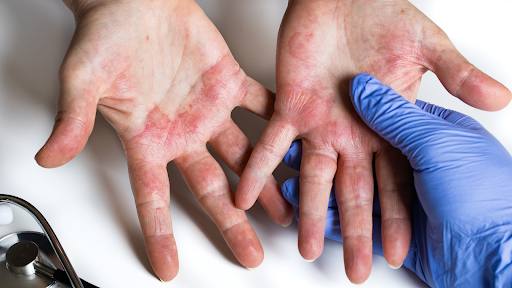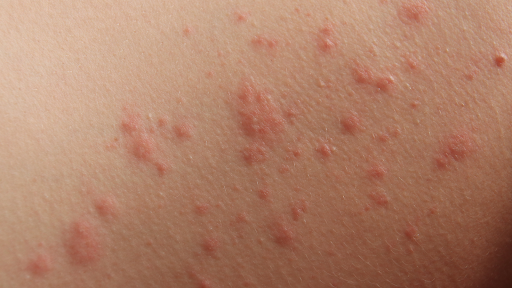Can Telehealth Prescribe Antibiotics for a UTI?
Urinary tract infections (UTIs) are among the most common bacterial infections, especially affecting women. They occur when bacteria enter the urinary system, causing [...]
Read More
Medically reviewed by Abhijit Bhattacharyya | MD, PhD, MBA, Tufts University School of Medicine - Miami, Florida on June 12th, 2025.
Eczema, also known as atopic dermatitis, is a common skin condition that affects millions of people worldwide. It manifests as dry, itchy, and inflamed skin, often leading to discomfort and distress. Understanding the various types of eczema and their symptoms can be crucial for effective management and treatment. This article will explore different types of eczemas, what to look for, and how to differentiate between them.
 Understanding Eczema
Understanding EczemaEczema is not a single condition but rather a term that encompasses several types of dermatitis. It can occur at any age, but it is most commonly seen in infants and young children. The exact cause of eczema is not fully understood, but it is believed to involve a combination of genetic and environmental factors. Factors such as family history of allergies, exposure to irritants, and even climate can play a significant role in the onset and severity of eczema symptoms. For many, the condition can be a source of frustration and discomfort, leading to a search for effective management strategies.
There are several types of eczema, each with its own characteristics and triggers. Some of the most common types include:
Atopic Dermatitis: The most common form, often associated with allergies and asthma.
Contact Dermatitis: Caused by direct contact with irritants or allergens.
Dyshidrotic Eczema: Characterized by small, itchy blisters on the hands and feet.
Nummular Eczema: Presents as circular, coin-shaped spots on the skin.
Seborrheic Dermatitis: Often affects oily areas of the body, such as the scalp and face.
The symptoms of eczema can vary widely depending on the type and severity. Common symptoms include:
Dry, sensitive skin
Intense itching
Red, inflamed patches
Thickened, scaly skin
Crusting or oozing lesions
In addition to these physical symptoms, eczema can also have a profound emotional impact on those affected. The persistent itching and visible skin changes can lead to feelings of embarrassment, anxiety, and even depression. Children with eczema may struggle with self-esteem issues, especially in social situations where their skin condition is noticeable. Furthermore, the cyclical nature of flare-ups can create a sense of unpredictability, making it challenging for individuals and their families to plan activities or outings. Understanding the psychological aspects of eczema is crucial in providing comprehensive care and support for those living with this condition.
Management of eczema often requires a multifaceted approach, including proper skincare routines, avoidance of known triggers, and sometimes, medication. Moisturizers play a vital role in maintaining skin hydration and barrier function, while topical corticosteroids may be prescribed to reduce inflammation during flare-ups. Additionally, lifestyle modifications, such as wearing breathable fabrics and using gentle, fragrance-free products, can help minimize irritation. For some individuals, dietary changes or allergy testing may also be beneficial in identifying specific triggers that exacerbate their symptoms. By taking a proactive stance, those affected by eczema can work towards achieving better skin health and overall well-being.
Visual identification of eczema can be helpful in understanding its various forms. Here are some key characteristics to look for in eczema rash pictures:
 Atopic dermatitis typically appears as red or brownish-gray patches on the skin. These patches can be found on:
Atopic dermatitis typically appears as red or brownish-gray patches on the skin. These patches can be found on:
Face and neck
Inside the elbows and knees
Hands and feet
In infants, it often appears on the scalp and face. Due to constant scratching, the skin may become thickened and leathery over time. This condition can also lead to secondary infections, as the broken skin becomes more susceptible to bacteria and viruses. It is not uncommon for individuals with atopic dermatitis to experience flare-ups triggered by environmental factors such as pollen, dust mites, or pet dander, making it crucial to identify and manage these triggers effectively.
 Contact dermatitis can be identified by its localized rash that occurs in direct response to an irritant or allergen. The rash may appear as:
Contact dermatitis can be identified by its localized rash that occurs in direct response to an irritant or allergen. The rash may appear as:
Red, itchy bumps
Blisters that may ooze
Dry, cracked skin
It is important to note that the rash usually appears in areas that have come into contact with the offending substance. Common irritants include soaps, detergents, and certain metals like nickel. In some cases, the reaction can be delayed, meaning that symptoms may not appear until days after exposure. Understanding the specific triggers can aid in prevention, and keeping a diary of products used can help identify potential allergens.
Dyshidrotic eczema is characterized by small, fluid-filled blisters that often appear on the fingers, palms, and soles of the feet. These blisters can be:
Extremely itchy
Accompanied by redness and swelling
After the blisters dry up, the skin may peel and become cracked, leading to further discomfort. This form of eczema is often exacerbated by stress and can be linked to seasonal allergies. Individuals may find that keeping their hands dry and avoiding excessive moisture can help reduce flare-ups. Additionally, wearing gloves when handling irritants or during household chores can serve as a protective measure to minimize skin irritation and maintain skin integrity.
To better understand the appearance of eczema, it can be useful to look at visual examples. Here are descriptions of various eczema rash pictures:
Images of atopic dermatitis typically show:
Red, inflamed patches on the skin
Dry, flaky skin with possible scaling
Areas of thickened skin from chronic scratching
These images can help individuals recognize the condition in themselves or others, facilitating early intervention. Atopic dermatitis is often associated with other allergic conditions, such as asthma and hay fever, making it essential to identify and manage symptoms effectively. The visual representation of atopic dermatitis can also highlight the varying severity of the condition, from mild irritation to severe outbreaks that can significantly impact quality of life.
In pictures of contact dermatitis, one might observe:
Localized redness and swelling
Blisters or hives in the affected area
Dry, peeling skin surrounding the rash
These visuals are essential for identifying potential irritants or allergens in one’s environment. Contact dermatitis can arise from a wide range of substances, including soaps, cosmetics, and even certain metals like nickel. By examining images of contact dermatitis, individuals can become more aware of their skin's reactions to various products, empowering them to make informed choices about their skincare routines and avoid triggers that may lead to flare-ups.
Images showcasing dyshidrotic eczema often depict:
Clusters of small blisters on the palms and fingers
Redness and swelling surrounding the blisters
Peeling skin after the blisters burst
Such images can help individuals understand the unique presentation of this eczema type. Dyshidrotic eczema is particularly common among people who experience high levels of stress or have a history of allergies. The visual representation of this condition can also illustrate the cyclical nature of flare-ups, which may be triggered by factors such as humidity or exposure to certain metals. Understanding these visual cues can aid in recognizing patterns and taking proactive measures to manage symptoms effectively.
Besides the common forms of eczema, there are less prevalent types that also warrant attention. Recognizing these can aid in proper diagnosis and treatment.
Nummular eczema is characterized by:
Round, coin-shaped patches that are often very itchy
Red or brownish spots that may crust over
Dry, scaly skin surrounding the patches
Images of nummular eczema help in distinguishing it from other types, as its circular shape is quite distinctive. This condition can often be triggered by dry skin, insect bites, or even exposure to harsh soaps and detergents. It is important to note that nummular eczema can occur at any age, but it is most commonly seen in middle-aged adults. The patches can sometimes merge together, forming larger areas of irritation, which can complicate treatment and management.
Images of seborrheic dermatitis typically show:
Greasy, yellowish scales on the scalp, face, or chest
Red patches that may be itchy or sore
Flaking skin that resembles dandruff
This type of eczema is often confused with other skin conditions, making visual representation crucial. Seborrheic dermatitis is particularly common in areas rich in oil glands, such as the scalp and face, and it can be exacerbated by stress, hormonal changes, and even weather conditions. Infants may also experience a form of this condition known as cradle cap, which manifests as thick, crusty patches on the scalp. Treatment options often include medicated shampoos and topical antifungal creams, which can effectively reduce the symptoms and promote healing.
Correct diagnosis is essential for effective treatment of eczema. A healthcare professional will typically perform a physical examination and may ask about personal and family medical history.
Diagnosis may involve:
A thorough examination of the rash and its characteristics
Reviewing potential triggers, such as allergens or irritants
Patch testing to identify specific allergens in cases of contact dermatitis
In some instances, a skin biopsy may be performed to rule out other skin conditions. This step is particularly important when the rash's presentation is atypical or when the response to standard treatments is inadequate. The biopsy can provide valuable insights into the underlying pathology, helping to differentiate eczema from other dermatological issues such as psoriasis or fungal infections. Additionally, a detailed patient history can reveal patterns related to the onset of symptoms, which can be crucial in identifying environmental factors or lifestyle choices that may exacerbate the condition.
Treatment for eczema can vary depending on the type and severity of the condition. Common treatment options include:
Topical Corticosteroids: These are often prescribed to reduce inflammation and itching.
Moisturizers: Regular application of emollients can help maintain skin hydration and barrier function.
Antihistamines: These may be recommended to relieve itching, especially at night.
Immunomodulators: Non-steroidal medications that help control inflammation.
In severe cases, systemic medications or phototherapy may be considered. Systemic treatments, such as corticosteroids or biologics, can provide relief for individuals with widespread or resistant eczema. Biologic therapies, in particular, have emerged as a promising option, targeting specific pathways in the immune system to reduce inflammation and prevent flare-ups.
Phototherapy, which involves controlled exposure to ultraviolet light, can also be effective, especially for patients who do not respond well to topical treatments. It is essential for patients to work closely with their healthcare providers to tailor a treatment plan that addresses their unique symptoms and lifestyle, ensuring a comprehensive approach to managing this chronic condition.
In addition to medical treatments, managing eczema at home can significantly improve symptoms and reduce flare-ups. Here are some strategies to consider:
 Establishing a consistent skincare routine is vital for individuals with eczema. Key components include:
Establishing a consistent skincare routine is vital for individuals with eczema. Key components include:
Using gentle, fragrance-free cleansers
Applying moisturizer immediately after bathing to lock in moisture
Avoiding hot showers, which can exacerbate dryness
Maintaining hydration is crucial for keeping the skin barrier intact.
Identifying and avoiding triggers is essential for managing eczema. Common triggers include:
Harsh soaps and detergents
Extreme temperatures and humidity
Stress and anxiety
Certain fabrics, such as wool
Keeping a diary to track flare-ups can help identify specific triggers and patterns.
Although the role of diet in eczema is still being studied, some individuals find that certain foods can exacerbate their symptoms. Common dietary triggers may include:
Dairy products
Nuts
Eggs
Wheat
Consulting with a healthcare provider or nutritionist can help in creating a balanced diet that minimizes flare-ups.
While many cases of eczema can be managed at home, there are instances when professional help is necessary. Seek medical advice if:
The rash is severe, widespread, or does not improve with over-the-counter treatments.
There are signs of infection, such as increased redness, swelling, or pus.
Itching is so intense that it disrupts sleep or daily activities.
Early intervention can prevent complications and improve quality of life.
Here’s a Doctronic-style conclusion for your eczema content, using the brand voice (empowering, approachable, trustworthy, innovative, inclusive) and speaking in “we/us” as a solution provider:
At Doctronic, we know that knowledge is the first step to relief. By recognizing what eczema looks like and how it shows up differently for everyone, you can confidently take charge of your skin health.
From identifying the type to exploring treatments that work for your lifestyle, we're here to simplify the process and support your next steps. Whether it’s home care tips or guidance on when to seek medical advice, our AI-powered doctor visits are free, fast, and built to meet you where you are.
Urinary tract infections (UTIs) are among the most common bacterial infections, especially affecting women. They occur when bacteria enter the urinary system, causing [...]
Read MoreManaging chronic conditions like type 2 diabetes and obesity can be challenging, but advances in medicine and technology are making treatment more accessible than ever. One [...]
Read MoreTelehealth has transformed the way people access healthcare by allowing patients to consult with medical professionals remotely, using digital platforms such as video calls, [...]
Read More